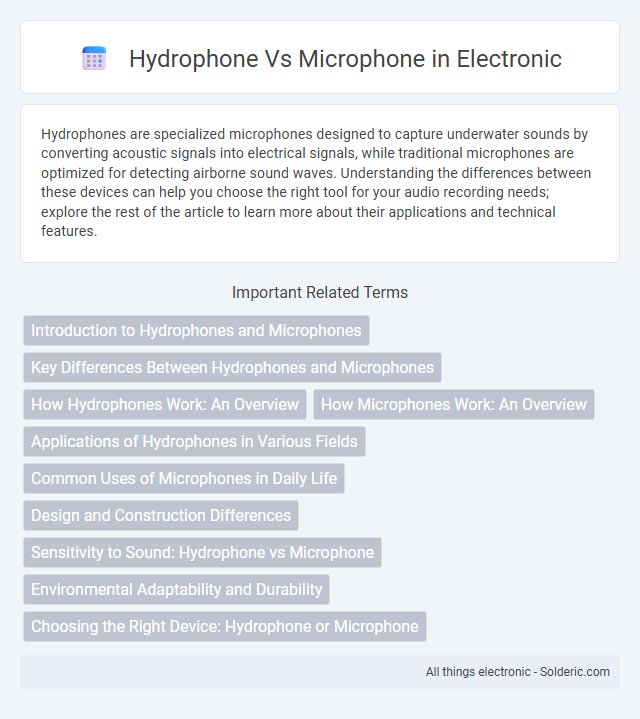Hydrophones are specialized microphones designed to capture underwater sounds by converting acoustic signals into electrical signals, while traditional microphones are optimized for detecting airborne sound waves. Understanding the differences between these devices can help you choose the right tool for your audio recording needs; explore the rest of the article to learn more about their applications and technical features.
Comparison Table
| Feature | Hydrophone | Microphone |
|---|---|---|
| Medium | Underwater (water) | Air |
| Purpose | Detect underwater sounds and vibrations | Detect airborne sounds and vibrations |
| Frequency Range | Typically 10 Hz to 100 kHz | Typically 20 Hz to 20 kHz |
| Sensitivity | High sensitivity to waterborne acoustic signals | High sensitivity to air pressure waves |
| Applications | Marine biology, underwater acoustics, sonar | Audio recording, communication, noise monitoring |
| Design | Waterproof, pressure-resistant casing | Typically not waterproof, designed for air |
| Signal Type | Converts underwater pressure changes to electrical signals | Converts air pressure changes to electrical signals |
Introduction to Hydrophones and Microphones
Hydrophones and microphones serve as specialized sensors for detecting sound waves in different environments; hydrophones are designed to capture underwater acoustic signals, whereas microphones detect airborne sound. Hydrophones use waterproof transducers to convert underwater pressure fluctuations into electrical signals, making them essential in marine research, sonar, and underwater communication. Your choice between these devices depends on the medium of sound transmission and the specific application requirements.
Key Differences Between Hydrophones and Microphones
Hydrophones are specialized sensors designed to detect sound waves underwater, converting acoustic signals into electrical signals, whereas microphones capture airborne sound waves in air. Hydrophones typically have waterproof casings and are calibrated to register low-frequency sounds with high sensitivity, making them ideal for underwater applications like marine research and submarine communication. Your choice between these devices depends on the medium--water or air--and the frequency range necessary for accurate sound detection.
How Hydrophones Work: An Overview
Hydrophones operate by converting underwater sound waves into electrical signals using piezoelectric materials that respond to pressure changes in water. Unlike microphones designed for air, hydrophones are specifically calibrated to detect acoustic signals in aquatic environments, enabling precise monitoring of marine life, submarine activity, and underwater communications. Your choice between a hydrophone and a microphone should consider the medium of sound transmission to ensure accurate audio capture.
How Microphones Work: An Overview
Microphones convert sound waves into electrical signals using a diaphragm that vibrates when hit by sound pressure, enabling audio capture for various applications. Hydrophones operate on a similar principle but are specifically designed to detect underwater acoustic signals by converting water pressure fluctuations into electrical signals. Your choice between a microphone and a hydrophone depends on whether you need to capture sound in air or underwater environments.
Applications of Hydrophones in Various Fields
Hydrophones are essential in underwater acoustics, widely used for marine biology research, seismic monitoring, and naval defense to detect submarines and underwater explosions. They enable precise recording of aquatic animal sounds and facilitate environmental monitoring of underwater habitats. Their unique sensitivity to waterborne sound waves distinguishes them from microphones, which are designed for air-based audio detection.
Common Uses of Microphones in Daily Life
Microphones are essential in daily life for capturing sound in various settings such as phone calls, voice recordings, and public speaking events. They convert acoustic signals into electrical signals, allowing clear communication and audio playback. Your smartphone, computer, and voice-activated devices all rely on microphones to function effectively.
Design and Construction Differences
Hydrophones are specifically designed to capture underwater sound waves, featuring waterproof and pressure-resistant casings that prevent damage in aquatic environments, unlike microphones that are optimized for air and typically use diaphragm-based designs suited for capturing airborne acoustic signals. Hydrophones often utilize piezoelectric materials that convert pressure changes in water into electrical signals, whereas conventional microphones rely on electromagnetic or capacitive elements to detect sound vibrations in the air. The structural design of hydrophones includes robust insulation and corrosion-resistant materials to withstand varying water temperatures and salinity, contrasting with microphones that prioritize sensitivity and frequency response for terrestrial audio capture.
Sensitivity to Sound: Hydrophone vs Microphone
Hydrophones exhibit higher sensitivity to low-frequency sound waves underwater, capturing acoustic signals that traditional microphones cannot detect due to the density and acoustic impedance of water. Microphones are optimized for air environments and demonstrate reduced sensitivity underwater because sound propagation differs significantly between air and water. Your choice between a hydrophone and a microphone should consider the medium and frequency range to ensure accurate sound detection and recording.
Environmental Adaptability and Durability
Hydrophones are specifically designed for underwater use, featuring waterproof and pressure-resistant materials that ensure optimal performance in aquatic environments, unlike standard microphones which are vulnerable to water damage and pressure changes. Their durability allows hydrophones to withstand harsh marine conditions, including saltwater corrosion and biofouling, making them ideal for long-term environmental monitoring and underwater research. Microphones, while robust for terrestrial applications, lack the specialized sealing and structural reinforcements needed for reliability and longevity in underwater settings.
Choosing the Right Device: Hydrophone or Microphone
Choosing between a hydrophone and a microphone depends on the medium in which sound is transmitted; hydrophones are specifically designed to detect underwater acoustic signals, capturing sound waves in aquatic environments with high sensitivity. Microphones are optimized for air-based sound detection, making them ideal for ambient noise, speech, and music recording in terrestrial settings. Selecting the correct device ensures accurate sound acquisition aligned with the operating environment and application requirements.
hydrophone vs microphone Infographic

 solderic.com
solderic.com